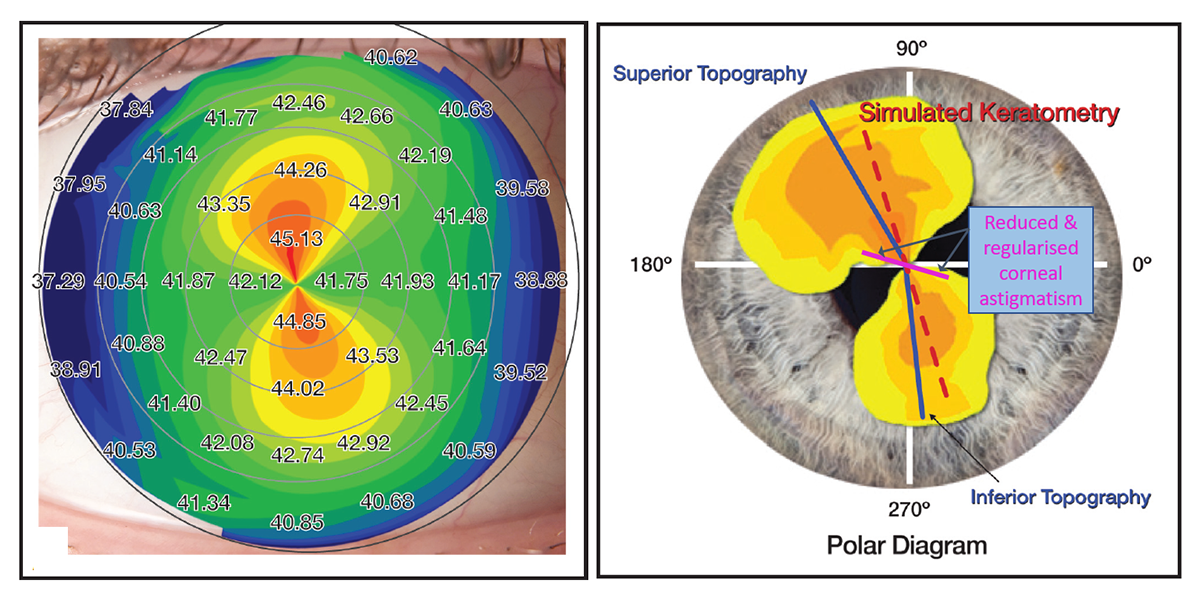This website uses cookies so that we can provide you with the best user experience possible. Cookie information is stored in your browser and performs functions such as recognising you when you return to our website and helping our team to understand which sections of the website you find most interesting and useful.
Research
Making laser eye surgery even more personal
A sophisticated new method of planning laser eye surgery has the potential to get patients closer to perfect vision than ever before.
For a surgeon planning laser eye surgery, identifying the optimal treatment of astigmatism has always been a challenge.
It is the shape of the cornea, the clear window at the front of the eye, that causes astigmatism, and a person’s spectacles that correct for it.
However, in many cases these two parameters differ in magnitude and direction.
Aiming to correct the astigmatism at the spectacle level will be at the expense at the cornea, leaving the eye with an avoidable uncorrected amount of astigmatism.
Finding a balance is not easy, but a new method for calculating astigmatic treatments – developed by Professor Noel Alpins AM to expand on his decades of work on Vector Planning for astigmatism with laser eye surgery – has the potential to get patients closer to their ideal vision than what has previously been possible.
Refractive errors
Refractive errors, such as short-sightedness and long-sightedness, are caused by long or short length in the eyes respectively, a corneal shape that is too steep or flat, or a combination of both.
An oval shaped cornea, which results in focusing light to two points of focus on the retina, causes astigmatism.
Astigmatism results in visual symptoms ranging from blurred or double vision at all distances to glare and halos from lights at night.
Astigmatism can also be categorized into regular and irregular types.
In regular astigmatism the typical shape of the cornea as displayed on topography maps is that of a bow-tie pattern, where the two halves of the cornea are symmetrical and orthogonal (in a straight line, fig. 1).
With irregular astigmatism, the two halves of the cornea are asymmetrical, non-orthogonal, or both (fig. 2).
Laser surgery can correct astigmatism by reshaping the cornea symmetrically to focus light back to the correct point.
However, astigmatism can be further customised to a person’s unique circumstance, particularly in eyes with irregular astigmatism.
“It’s very common to be short sighted or long sighted with astigmatism,” says Professor Noel Alpins OA, long-time CERA supporter and honorary Clinical Professor at the University of Melbourne.
“This can be corrected at the same time as regular astigmatism, or irregular where the bow-tie is uneven or bent.”
Professor Alpins says if astigmatism did not exist, refractive surgery to correct long or short sightedness would be relatively straightforward.
“The practitioner would need only flatten or steepen corneal curvature to the proper amount to produce a focussed image on the patient’s retina.”
However, with astigmatism it is much more challenging.

Vector planning
Professor Alpins’ new method for planning laser eye surgery to correct astigmatism builds on his decades of experience in the field.
The Alpins Method, first introduced almost 30 years ago and now an international standard in astigmatism treatment and analysis, incorporates the method of Vector Planning used to find the best possible vision outcome for a patient with astigmatism.
Vector Planning reshapes the cornea in a way that strikes a balance between the astigmatism measured in spectacles and that on the cornea.
By aiming to optimally reduce the astigmatism on the cornea, patients can be left with better vision than treatment based on the spectacles alone.
The new update to the treatment of regular and irregular astigmatism takes this customisation even further.
As described in his recently published paper Hemidivisional Vector Planning to reduce and regularize irregular astigmatism by laser treatment, recently published in Graefe’s Archive for Clinical and Experimental Ophthalmology, the new method conceptually divides the cornea into two, with Vector Planning applied independently to each half of the cornea to maximally reduce the total astigmatism.
Since the astigmatism can now be measured for each half of the cornea, this extra layer of calculation provides even greater accuracy to reduce and regularise the corneal astigmatism.
“Since we can do this calculation to the whole cornea, we wondered why couldn’t we consider the treatment of the cornea in two parts, get the measurements for each half and customise the treatment even further?” says Professor Alpins.
This method not only provides a maximal reduction in astigmatism but also regularises any remaining corneal astigmatism resulting in a symmetrical, orthogonal cornea which has the potential to improve a patient’s best corrected visual acuity and reduce remaining aberrations.
It is important to note that the reduction and regularisation of corneal astigmatism is beneficial to all treatments whether the astigmatism is regular or irregular.
This outcome potentially results in better quality of vision without glasses or contact lenses.
“We’re asking: What is the optimum shape of the cornea? It is the shape that leaves people out of glasses with the best quality vision,” says Professor Alpins.
“This form of hemidivisional Vector Planning is all about trying to give someone the eyes they should have had at birth without the distortions of irregular or avoidable astigmatism remaining.”
While the new method is not yet implemented in current laser surgery devices, the Designer Cornea calculator is already available free online for investigational use by ophthalmologists to guide the treatments in conjunction with excimer or femtosecond refractive laser device manufacturers.
The full paper: Hemidivisional vector planning to reduce and regularize irregular astigmatism by laser treatment is also available online.

